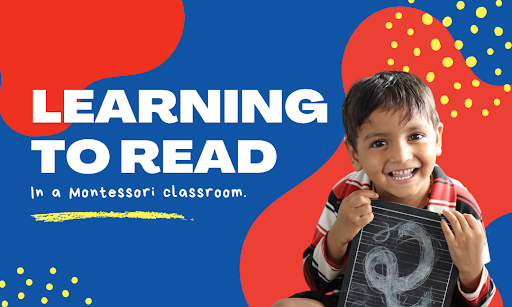All educators can agree that reading is critically important to a student’s future success in modern American life. What they can’t agree upon is how to teach reading. Esteemed academics and tenured educators debate and implement the next best methodology every few years, with various curricula coming in and out of fashion in a seemingly cyclical nature.
The Montessori Method was developed in the early 1900s and has remained mostly unchanged since its initial implementation. That’s because the Montessori Method centers around the biological development of the child, which has remained the same since the beginning of human history.
Children in Montessori Schools learn to read successfully, but the methods that we use and the approach we take might seem different to families who are familiar with traditional American schooling methodology. While there isn’t a wide-scale peer-reviewed study of literacy in the Montessori method, a few localized reports have pointed to the ways that the Montessori approach to reading decreases the literacy gap associated with socioeconomic status and race, fosters better writing skills and encourages children to read more frequently than their traditionally educated peers.1
So, how does the Montessori Method teach children to read? The approach is ultimately individualized to meet each unique child’s needs and mirrors how we teach almost all lessons in a Montessori environment. We’ll highlight some of the things that make our approach to reading unique!
The child leads reading progression.
If you know and love a toddler, then you know that they rarely do anything that they don’t want to do. Learning to read is ultimately a choice, one that we cannot make for a child. The process, though seemingly simple to everyone who can read and write, is incredibly challenging in practice. It requires recognition, interpretation and translation skills that can take half of a lifetime to master. So in a Montessori environment, we introduce the building blocks of reading in a way that is interesting to the child. By tapping into their natural curiosity, we impart lessons upon them in letter formation, recognition and interpretation. How do we do that…
Physical movement is key.
Young children love to explore objects with their senses. Examining textures, weights and shapes is part of how they start to categorize the world. With this in mind, Montessori guides strategically place foundational reading materials that tap into the sense of touch throughout the classroom. If you were to visit our toddler, primary and elementary environments, you would find movable letter sets in various shapes, sizes and textures. Our children use these to practice letter recognition and formation, physically moving the elements and aligning them to form words. Creating and using materials that engage multiple senses helps pique their interest in reading.
The reading process is interdisciplinary.
If you’ve read our past posts about the way we teach lessons in our classrooms, then you have read that all of our materials teach multiple lessons. Learning to read in a Montessori classroom is no different. In Montessori environments, reading and writing materials come in tandem. Often, children learn the foundation of writing and letter formation before they start recognizing letters and decoding sounds. Part of what is impactful about our method is that reading is all around the child! There is no time set aside for science, math, history or language arts – all of the lessons are taking place simultaneously as the child explores the environment. So learning to read isn’t reserved for a set time in the morning, it is part of almost every activity that a young child does throughout their school day.
We model a love of reading.
One thing that is shared among all educators is a belief that a love of reading is an incredibly important foundation of education. If we can teach children to love reading and learning, they will have a much more productive educational experience no matter what type of schooling they pursue. At Maria Montessori School, our library is filled with books that span topics and genres. Younger students watch as older students and guides engage with the books in our library, and they pick up on the excitement of discovering and reading a new book for the first time. Through reading aloud and modeling reading as a regular practice, we hope to demonstrate to our early readers that reading is a practice worth keeping throughout their life!
Resources
1. MontessoriPublic – Montessori as a reading intervention (Fall 2021) Page 21

